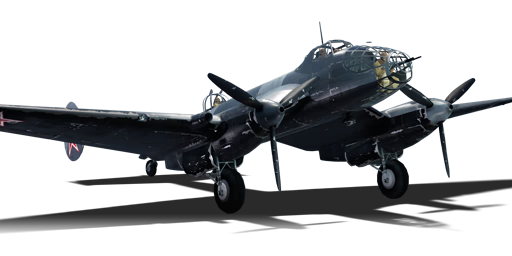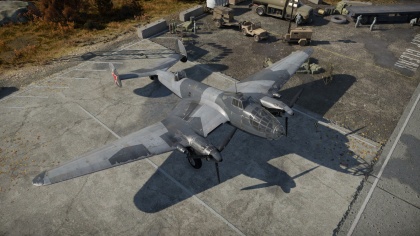Yer-2 (ACh-30B) (l)
Contents
| This page is about the Russian bomber Yer-2 (ACh-30B) (l). For the Early version, see Yer-2 (ACh-30B) (e). For other versions, see Yer-2 (Family). |
Description
The Yer-2 (ACh-30B) Late is a rank IV Russian bomber
with a battle rating of 4.7 (AB), 4.3 (RB), and 5.7 (SB). It has been in the game since the start of the Open Beta Test prior to Update 1.27.
The Yer-2 ACh-30B is the last traditional heavy bomber in the Soviet line-up until you get to the feared Tu-4, and it retains its previous model's strengths and weaknesses. The main draw of this variant is the gigantic payload at its disposal (up to 5,000 kg), being the second best at the BR behind the British Lancaster. A squad of Yer-2's can easily win games if left alone, and thus it has gained a notoriety among players as an extremely high value target that should be destroyed at all costs, with some players even resorting to ramming the bomber if needed. The plane's defensive armament is decent for the tier, but won't stop heavily armoured interceptors such as the Fw 190 D-9, P-38L-5-LO or the feared F-82E, and thus engagements must be avoided at all costs.
General info
Flight performance
Describe how the aircraft behaves in the air. Speed, manoeuvrability, acceleration and allowable loads - these are the most important characteristics of the vehicle.
| Characteristics | |||||||
|---|---|---|---|---|---|---|---|
| Stock | |||||||
| Max Speed (km/h at 6,000 m) |
Max altitude (meters) |
Turn time (seconds) |
Rate of climb (meters/second) |
Take-off run (meters) | |||
| AB | RB | AB | RB | AB | RB | ||
| 397 | 385 | 11000 | 49.1 | 50.1 | 7.9 | 7.8 | 1,800 |
| Upgraded | |||||||
| Max Speed (km/h at 6,000 m) |
Max altitude (meters) |
Turn time (seconds) |
Rate of climb (meters/second) |
Take-off run (meters) | |||
| AB | RB | AB | RB | AB | RB | ||
| ??? | 415 | 11000 | ??.? | 48.0 | ??.? | 9.5 | 1,800 |
Details
| Features | ||||
|---|---|---|---|---|
| Combat flaps | Take-off flaps | Landing flaps | Air brakes | Arrestor gear |
| ✓ | ✓ | ✓ | X | X |
| Limits | ||||
|---|---|---|---|---|
| Wing-break speed (km/h) |
Gear limit (km/h) |
Combat flaps (km/h) |
Max Static G | |
| + | - | |||
| 470 | ~2 | ~1 | ||
| Optimal velocities | |||
|---|---|---|---|
| Ailerons (km/h) |
Rudder (km/h) |
Elevators (km/h) |
Radiator (km/h) |
| < 290 | < 300 | < 270 | > 330 |
| Compressor (RB/SB) | ||
|---|---|---|
| Setting 1 | ||
| Optimal altitude | 100% Engine power | WEP Engine power |
| 5,700 m | 1,300 hp | 1,459 hp |
Survivability and armour
- 15 mm steel plate behind the pilot
- 15 mm steel plate behind the co-pilot
- 15 mm steel plate in front of rear ball gunner
Armaments
Suspended armament
The Yer-2 (ACh-30B) (l) can be outfitted with the following ordnance:
- 20 x 100 kg FAB-100 bombs (2,000 kg total)
- 8 x 250 kg FAB-250M43 bombs (2,000 kg total)
- 4 x 500 kg FAB-500 bombs (2,000 kg total)
- 3 x 1,000 kg FAB-1000 bombs (3,000 kg total)
- 3 x 1,000 kg FAB-1000 bombs + 20 x 100 kg FAB-100 bombs (5,000 kg total)
- 3 x 1,000 kg FAB-1000 bombs + 8 x 250 kg FAB-250M43 bombs (5,000 kg total)
- 3 x 1,000 kg FAB-1000 bombs + 4 x 500 kg FAB-500 bombs (5,000 kg total)
Defensive armament
The Yer-2 (ACh-30B) (l) is defended by:
- 1 x 20 mm ShVAK cannon, dorsal turret (200 rpg)
- 1 x 12.7 mm Berezin UB machine gun, nose turret (195 rpg)
- 1 x 12.7 mm Berezin UB machine gun, ventral turret (275 rpg)
Usage in battles
The Yer-2 with upgraded ACh-30B engines plays similarly to the previous model of Yer-2's, but with overall parameters and performance improved. It has a larger payload, better defensive armament and is faster than the previous model. However, this isn't saying much considering the speed improvement is negligible and the defensive armament can easily be avoided by a skilled pilot. As such, you should avoid any form of engagement at all costs. Despite these shortcomings, the thing that gained the Yer-2 its notoriety is its massive 5,000 kg payload. The Yer-2 was the reason why you had to destroy all of the mini-bases before moving onto the airfield, as it made games last incredibly short periods of time, and a fleet of Yer-2's was almost unstoppable. In the present day however, this is not the case, and it will take multiple Yer-2's working together to destroy the bases and airfield or just one very persistent and determined Yer-2.
- Playstyles
- High altitude bomber: The high altitude mentality of bombers can be used, but this is hampered by the poor performance the Yer-2 offers above 4,000 meters due to its engine not receiving enough oxygen. While the safest, it is definitely the slowest. It is recommended to side climb at the start of a match to avoid confrontation and gain altitude quickly. Ideal altitude for this playstyle is around 6,000 - 6,500 meters, as you can avoid being noticed, and planes that do notice you will have trouble climbing there in a quick fashion.
- Medium altitude bomber: The role the Yer-2 was designed for, the player can stay around 3,000 - 4,000 meters and flank around the map towards bases. It is recommended to use this playstyle when the aircraft is spaded, as you have a higher chance of being attacked by enemy fighters who see the Yer-2 as easy prey. Maintain speed and take a long way around to bases and when you have destroyed all of them, you are free to go for ground targets.
Manual Engine Control
| MEC elements | ||||||
|---|---|---|---|---|---|---|
| Mixer | Pitch | Radiator | Supercharger | Turbocharger | ||
| Oil | Water | Type | ||||
| Not controllable | Controllable Not auto controlled |
Not controllable Not auto controlled |
Controllable Not auto controlled |
Combined | Not controllable 1 gear |
Auto controlled |
Modules
| Tier | Flight performance | Survivability | Weaponry | ||
|---|---|---|---|---|---|
| I | Fuselage repair | Radiator | Turret 12 mm | Der-19-20 | |
| II | Compressor | Airframe | New 12 mm MGs (turret) | KD-3-240 | |
| III | Wings repair | Engine | Turret 20 mm | ||
| IV | Engine injection | Cover | New 20 mm cannons (turret) | ||
- Being a heavy strategic bomber, you should go for the bomb load upgrades first followed by turret 12 mm and 20 mm belts, as the ball ammo in the 12 mm belts is completely useless and the Berezin MG's belts are loaded with incendiary rounds, increasing the chance of starting fires on attackers. The rest of the modules are up to the player, but the survivability modules are recommended to withstand the beating you will be getting by fighters and interceptors.
Pros and cons
Pros:
- Massive payload, second best of any non-premium bomber at the BR
- Relatively powerful defensive armament
- Two pilots, if one gets knocked out the other can still fly
- Elevators are surprisingly responsive
Cons:
- Very slow
- Defensive armament won't do anything versus heavily armoured interceptors.
- Wings are massive and flimsy, making them easy targets
- Even for a heavy bomber, the manoeuvrability is poor
- Performance suffers significantly above 4,000 meters
- Carrying the largest payload has a noticeable effect on performance
- Wings are littered with fuel tanks
- Pilots are placed very close to each other
- Reputation; Enemies will climb to your altitude specifically to destroy you due to your notoriety
History
Describe the history of the creation and combat usage of the aircraft in more detail than in the introduction. If the historical reference turns out to be too long, take it to a separate article, taking a link to the article about the vehicle and adding a block "/ History" (example: https://wiki.warthunder.com/(Vehicle-name)/History) and add a link to it here using the main template. Be sure to reference text and sources by using <ref></ref>, as well as adding them at the end of the article with <references />. This section may also include the vehicle's dev blog entry (if applicable) and the in-game encyclopedia description (under === In-game description ===, also if applicable).
In-game description
The command staff of the Long-Range Air Force (LRAF) proposed adding a second pilot to the Yer-2's crew, placing him next to the commander. This decision significantly reduced the workload imposed on pilots during long flights.
The pilot's cockpit now had two seats, and its appearance was completely changed. The pilots' chairs were located side by side (the commander's to the left and the co-pilot's to the right) under the improved canopy, which was now the classical type instead of the earlier asymmetrical version.
The navigator's station was shifted to the forward section of the fuselage. The elliptical outlines of the forward section common to the Yer-2 were now straightened, and the upper section of the navigator's cockpit was lowered. These improvements only barely influenced the plane's flight characteristics, but they noticeably improved visibility from the pilot's cockpit. The navigator's work with his sextant became easier, thanks to the transparent astrodome.
An OPB-2R sight was mounted instead of the PS-1 sight, resulting in the removal of its external fairing.
Yer-2 bombers with the new two-seat cockpit and the new navigator's cockpit were produced at Factory No. 39 beginning in August 1944. 101 aircraft were built. Production continued into 1945, with the number of planes reaching 241.
Yer-2 bombers built at the factory in Irkutsk entered service beginning in February 1944. Although these aircraft reached the front line when the war with Germany was almost over, they were used actively enough on the Northwestern and Baltic Fronts. Yer-2s made a significant contribution to the successful assault of the fortress city of Königsberg with their large-sized bombs.
Based on their combat experience, the various crews formed a generally favourable attitude towards the Yer-2, built with ACh-30B diesel engines. The pilots liked its comfortable cockpit with excellent visibility, powerful defensive armament, large bomb capacity, and strong airframe structure. The aircraft's high survivability was also noted. Yer-2s with diesel engines practically never caught fire, since kerosene was much more difficult to ignite than petrol.
Yer-2 bombers were withdrawn from service in 1946.
Media
Excellent additions to the article would be video guides, screenshots from the game, and photos.
See also
External links
Paste links to sources and external resources, such as:
- topic on the official game forum;
- encyclopedia page on the aircraft;
- other literature.
| USSR bombers | |
|---|---|
| SB and Ar | SB 2M-100 · SB 2M-103 · SB 2M-103 MV-3 · SB 2M-103U · SB 2M-103U MV-3 · SB 2M-105 · Ar-2 |
| Yer-2 (petrol) | Yer-2 (M-105) · Yer-2 (M-105) TAT · Yer-2 (M-105R) TAT · Yer-2 (M-105R) LU |
| Yer-2 (diesel) | Yer-2 (ACh-30B) (e) · Yer-2 (ACh-30B) (l) |
| Tu | Tu-2 · Tu-2S · Tu-2S-44 · Tu-2S-59 · Tu-4 |
| Pe | Pe-2-1 · Pe-2-31 · Pe-2-83 · Pe-2-110 · Pe-2-205 · Pe-2-359 · Pe-8 |
| IL | DB-3B · IL-4 |
| Po | Po-2 · Po-2M |
| Other | MBR-2-M-34 · TB-3M-17-32 · Yak-4 · Be-6 |
| Lend-Lease | ▂PBY-5A Catalina · ▂Hampden TB Mk I · ▂A-20G-30 · ▂B-25J-30 |





